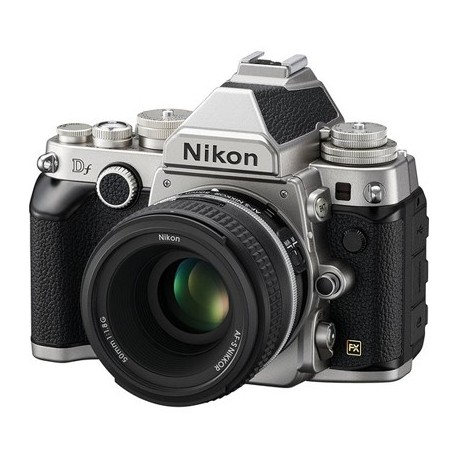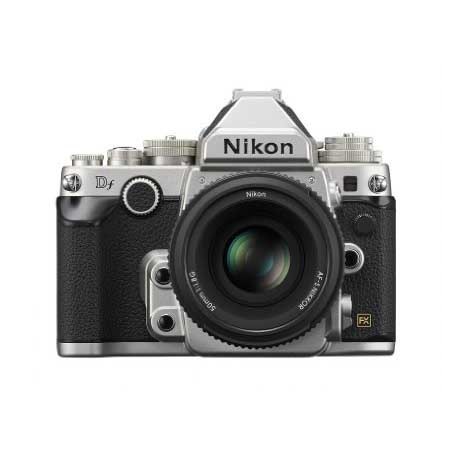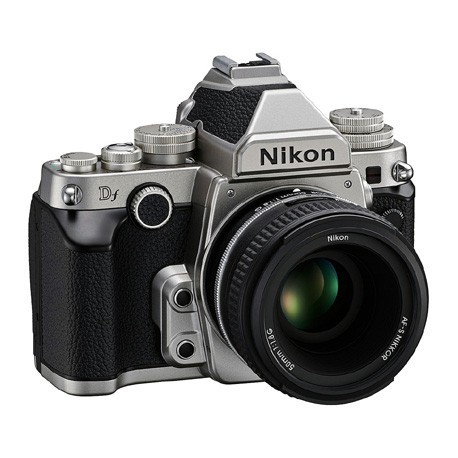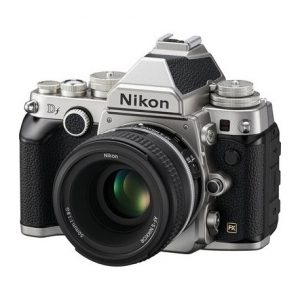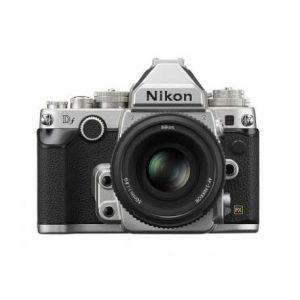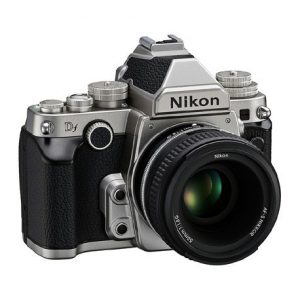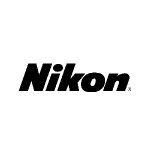Description
Nikon DF with AF-S NIKKOR 50mm f/1.8G
Df: the concept behind the “f”
Using its large, metallic mechanical dials, photographers will rediscover a more direct connection with their camera. This is Nikon’s smallest, lightest FX-format body, yet it delivers the same exceptional image quality as the D4 – from low to extremely high ISO. The Df represents a fusion between tactile precision mechanics and the exquisite image quality of the flagship camera D4, stimulating artistic sensibilities and inspiring photographers to new levels of creativity beyond previous limitations of time, place and volume of available light. This is Nikon’s proposal to passionate photographers: rediscover the fulfillment of measured, deliberate photography, and create your pictures one frame at a time.
Tactile precision mechanics to inspire photographers
The large mechanical dials on the top deck are carved from solid metal in order to allow more direct and purposeful exposure control. Photographers have easy access to a diverse array of innovative features, helping them create one-of-a-kind images. That’s what the Df is built for: helping photographers relay their ideas more intuitively via mechanical dials, and then using cutting-edge innovations to produce the results they envisioned. With the Df, each frame becomes meaningful again.
A fusion of D4 image quality and lightweight mobility
Designed to travel, the Df has the smallest and lightest body among Nikon FX-format models, and in pursuit of pleasurable operability, the camera body was designed with sharp angles on its exterior to accommodate the large mechanical dials. Photographers can easily take the camera anywhere and use it comfortably for longer periods of time. On top of that, the Df incorporates the same FX-format CMOS sensor and EXPEED 3 image-processing engine as the D4. Expect exceptionally versatile image quality – from ISO 100 to 12800.
| Type | ||
| Type | Single-lens reflex digital camera | |
| Lens mount | Nikon F mount (with AF coupling and AF contacts) | |
| Effective angle of view | Nikon FX format | |
| Effective pixels | ||
| Effective pixels | 16.2 million | |
| Image sensor | ||
| Image sensor | 36.0 x 23.9 mm CMOS sensor | |
| Total pixels | 16.6 million | |
| Dust-reduction system | Image sensor cleaning, Image Dust Off reference data (optional Capture NX 2 software required) | |
| Storage | ||
| Image size (pixels) | FX format (36×24): 4,928 x 3,280 [L], 3,696 x 2,456 [M], 2,464 x 1,640 [S] | |
| DX format (24×16): 3,200 x 2,128 [L], 2,400 x 1,592 [M], 1,600 x 1,064 [S] | ||
| File format | NEF (RAW): 12 or 14 bit, lossless compressed, compressed, or uncompressed | |
| TIFF (RGB) | ||
| JPEG: JPEG-Baseline compliant with fine (approx. 1:4), normal (approx. 1:8) or basic (approx. 1:16) compression (Size priority); Optimal quality compression available | ||
| NEF (RAW)+JPEG: Single photograph recorded in both NEF (RAW) and JPEG formats | ||
| Picture Control System | Standard, Neutral, Vivid, Monochrome, Portrait, Landscape; selected Picture Control can be modified; storage for custom Picture Controls | |
| Media | SD (Secure Digital) and UHS-I compliant SDHC and SDXC memory cards | |
| File system | DCF (Design Rule for Camera File System) 2.0, DPOF (Digital Print Order Format), Exif (Exchangeable Image File Format for Digital Still Cameras) 2.3, PictBridge | |
| Viewfinder | ||
| Viewfinder | Eye-level pentaprism single-lens reflex viewfinder | |
| Frame coverage | FX (36×24): Approx. 100% horizontal and 100% vertical | |
| DX (24×16): Approx. 97% horizontal and 97% vertical | ||
| Magnification | Approx. 0.7x (50 mm f/1.4 lens at infinity, -1.0 m-1) | |
| Eyepoint | 15 mm (-1.0 m-1; from center surface of viewfinder eyepiece lens) | |
| Diopter adjustment | -3 to +1 m-1 | |
| Focusing screen | Type B BriteView Clear Matte Mark VIII screen with AF area brackets (framing grid can be displayed) | |
| Reflex mirror | Quick return | |
| Depth-of-field preview | Pressing Pv button stops lens aperture down to value selected by user (exposure modes A and M) or by camera (exposure modes P and S) | |
| Lens aperture | Instant return, electronically controlled | |
| Lens | ||
| Compatible lenses | Compatible with AF NIKKOR lenses, including type G, E, and D lenses (some restrictions apply to PC lenses) and DX lenses (using DX 24 x 16 1.5x image area), AI-P NIKKOR lenses and non-CPU lenses. IX NIKKOR lenses and lenses for the F3AF cannot be used. The electronic rangefinder can be used with lenses that have a maximum aperture of f/5.6 or faster (the electronic rangefinder supports the center 7 focus points with lenses that have a maximum aperture of f/8 or faster and the center 33 focus points with lenses that have a maximum aperture of f/7.1 or faster) | |
| Shutter | ||
| Type | Electronically controlled vertical-travel focal-plane shutter | |
| Speed | 1/4,000 to 4 s in steps of 1 EV (1/4,000 s to 30 s in steps of 1/3 EV with main command dial), X200 (with shutter-speed dial only), bulb, time | |
| Flash sync speed | X=1/200 s; synchronizes with shutter at 1/250 s or slower | |
| Release | ||
|
S (single frame), CL (continuous low speed), CH (continuous high speed), Q (quiet shutter-release), | |
| (self-timer), MUP (mirror up) | ||
| Frame advance rate | 1 to 5 fps (CL) or 5.5 fps (CH) | |
| Self-timer | 2 s, 5 s, 10 s, 20 s; 1 to 9 exposures at intervals of 0.5, 1, 2 or 3 s | |
| Exposure | ||
| Metering | TTL exposure metering using 2,016-pixel RGB sensor | |
| Metering method | Matrix: 3D color matrix metering II (type G, E and D lenses); color matrix metering II (other CPU lenses); color matrix metering available with non-CPU lenses if user provides lens data | |
| Center-weighted: Weight of 75% given to 12-mm circle in center of frame; diameter of circle can be changed to 8, 15 or 20 mm, or weighting can be based on average of entire frame (non-CPU lenses use 12-mm circle) | ||
| Spot: Meters 4-mm circle (about 1.5% of frame) centered on selected focus point (on center focus point when non-CPU lens is used) | ||
| Range | Matrix or center-weighted metering: 0 to 20 EV | |
| (ISO 100, f/1.4 lens, 20°C/68°F) | Spot metering: 2 to 20 EV | |
| Exposure meter coupling | Combined CPU and AI (collapsible metering coupling lever) | |
| Exposure modes | Programmed auto with flexible program (P); shutter-priority auto (S); aperture-priority auto (A); manual (M) | |
| Exposure compensation | -3 to +3 EV in increments of 1/3 EV | |
| Exposure bracketing | 2 to 5 frames in steps of 1/3, 2/3, 1, 2 or 3 EV | |
| Flash bracketing | 2 to 5 frames in steps of 1/3, 2/3, 1, 2 or 3 EV | |
| Exposure lock | Luminosity locked at detected value with AE-L/AF-L button | |
| ISO sensitivity | ISO 100 to 12800 in steps of 1/3 EV; can also be set to approx. 0.3, 0.7 or 1 EV (ISO 50 equivalent) below ISO 100 or to approx. 0.3, 0.7, 1, 2, 3 or 4 EV (ISO 204800 equivalent) above ISO 12800; auto ISO sensitivity control available | |
| (Recommended Exposure Index) | ||
| Active D-Lighting | Can be selected from Auto, Extra high +2/+1, High, Normal, Low, or Off | |
| ADL bracketing | 2 frames using selected value for one frame or 3 to 5 frames using preset values for all frames | |
| Focus | ||
| Autofocus | Nikon Multi-CAM 4800 autofocus sensor module with TTL phase detection, fine-tuning, and 39 focus points (including 9 cross-type sensors; the center 33 points are available at apertures slower than f/5.6 and faster than f/8, while the center 7 focus points are available at f/8) | |
| Detection range | -1 to +19 EV (ISO 100, 20°C/68°F) | |
| Lens servo | Autofocus (AF): Single-servo AF (AF-S); continuous-servo AF (AF-C); predictive focus tracking activated automatically according to subject status | |
| Manual focus (M): Electronic rangefinder can be used | ||
| Focus point | Can be selected from 39 or 11 focus points | |
| AF-area modes | Single-point AF, 9-, 21- or 39-point dynamic-area AF, 3D-tracking, auto-area AF | |
| Focus lock | Focus can be locked by pressing shutter-release button halfway (single-servo AF) or by pressing AE-L/AF-L button | |
| Flash | ||
| Flash control | TTL: i-TTL flash control using 2,016-pixel RGB sensor is available with SB-910, SB-900, SB-800, SB-700, SB-600, SB-400 or SB-300; i-TTL balanced fill-flash for digital SLR is used with matrix and center-weighted metering, standard i-TTL flash for digital SLR with spot metering | |
| Flash modes | Front-curtain sync, slow sync, rear-curtain sync, red-eye reduction, red-eye reduction with slow sync, slow rear-curtain sync, Auto FP High-Speed Sync supported | |
| Flash compensation | -3 to +1 EV in increments of 1/3 | |
| Flash-ready indicator | Lights when optional flash unit is fully charged; flashes after flash is fired at full output | |
| Accessory shoe | ISO 518 hot-shoe with sync and data contacts and safety lock | |
| Nikon Creative Lighting | Advanced Wireless Lighting supported with SB-910, SB-900, SB-800 or SB-700 as a master flash and SB-600 or SB-R200 as remotes, or SU-800 as commander; Auto FP High-Speed Sync and modeling illumination supported with all CLS-compatible flash units except SB-400 and SB-300; Flash Color Information Communication and FV lock supported with all CLS-compatible flash units | |
| System (CLS) | ||
| Sync terminal | ISO 519 sync terminal with locking thread | |
| White balance | ||
| White balance | Auto (2 types), incandescent, fluorescent (7 types), direct sunlight, flash, cloudy, shade, preset manual (up to 4 values can be stored, spot white balance measurement available during live view), choose color temperature (2,500 K to 10,000 K); all with fine-tuning | |
| White balance bracketing | 2 to 3 frames in steps of 1, 2 or 3 | |
| Live View | ||
| Lens servo | Autofocus (AF): Single-servo AF (AF-S); full-time servo AF (AF-F) | |
| Manual focus (M) | ||
| AF-area modes | Face-priority AF, wide-area AF, normal-area AF, subject-tracking AF | |
| Autofocus | Contrast-detect AF anywhere in frame (camera selects focus point automatically when face-priority AF or subject-tracking AF is selected) | |
| Monitor | ||
| Monitor | 8-cm (3.2-in.), approx. 921k-dot (VGA), low-temperature polysilicon TFT LCD with approx. 170° viewing angle, approx. 100% frame coverage, and brightness control | |
| Playback | ||
| Playback | Full-frame and thumbnail (4, 9 or 72 images or calendar) playback with playback zoom, photo slide shows, histogram display, highlights, photo information, location data display, and auto image rotation | |
| Interface | ||
| USB | Hi-Speed USB | |
| HDMI output | Type C mini-pin HDMI connector | |
| Accessory terminal | Wireless remote controllers: WR-R10 and WR-1 (available separately) | |
| Remote cord: MC-DC2 (available separately) | ||
| GPS units: GP-1/GP-1A (available separately) | ||
| Supported languages | ||
| Supported languages | Arabic, Chinese (Simplified and Traditional), Czech, Danish, Dutch, English, Finnish, French, German, Greek, Hindi, Hungarian, Indonesian, Italian, Japanese, Korean, Norwegian, Polish, Portuguese (Portugal and Brazil), Romanian, Russian, Spanish, Swedish, Thai, Turkish, Ukrainian | |
| Power source | ||
| Battery | One EN-EL14a Rechargeable Li-ion Battery | |
| AC adapter | EH-5b AC Adapter; requires EP-5A Power Connector (available separately) | |
| Tripod socket | ||
| Tripod socket | 1/4 in. (ISO 1222) | |
| Dimensions / weight | ||
| Dimensions | Approx. 143.5 x 110 x 66.5 mm/ 5.6 x 4.3 x 2.6 in. | |
| (W x H x D) | ||
| Weight | Approx. 765 g/1 lb 11 oz with battery and memory card but without body cap; approx. 710 g/1 lb 9 oz (camera body only) | |
| Operating environment | ||
| Operating environment | Temperature: 0 to 40°C/32 to 104°F; humidity: 85% or less (no condensation) | |
| Accessories | ||
| Supplied accessories | EN-EL14a Rechargeable Li-ion Battery, MH-24 Battery Charger, DK-26 Eyepiece Cap, String for eyepiece cap, UC-E6 USB Cable, AN-DC9 Camera Strap, BF-1B Body Cap, BS-1 Accessory Shoe Cover, ViewNX 2 CD-ROM | |
| (may differ by country or area) | ||

